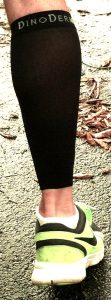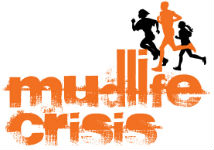There are a ton of tools that runners, obstacle racers, and other endurance athletes either absolutely swear by or get downright irate and nearly irrationally negative about when it comes to training and performance. Diet (high-carb or low-carb? Vegetarian or omnivorous?). Stretching (before, after, or at all?). Mileage (short runs with a long weekend run, or mid-range miles all week?). And one of these has to do with a piece of gear that I’m planning to try for the first time at this weekend’s Spartan Sprint – Ohio: compression gear.
What is compression gear?

Compression sleeves like these may help many athletes to avoid injury and soreness.
Simply stated, compression gear is clothing that fits tightly around part of the body. Usually you’ll see compression socks, sleeves for the arms or calves, shorts (that have mercifully replaced jock straps for many athletes), tights, and shirts.
How does compression gear work?
The idea is that the compression action of the garment can reduce cramping and fatigue in the area of the body that the garment is covering. This happens because circulation is increased in the compressed body part, increasing blood and lymph flow in the body part and pushing recovery into the area. The manufacturers of such products claim that they increase oxygen flow and push lactic acid out of the covered area, thereby aiding in the performance and recovery.
What's compression gear all about, and is it good for #OCR? Click To TweetMany scientists claim that this is a load of bunk and that there’s no evidence to support the claims of increased performance. Though there are studies that show an improvement, none of them (according to this article, anyway) have used a placebo to test whether this was a placebo effect situation. Other scientists say that while lab tests have been less than conclusive, field tests have been very positive. Evidence is better that they do help with recovery than in-event performance, but there’s evidence for both.
That being said, there are numerous anecdotal stories from athletes about how they help with performance and recovery. And the consensus is that even if it is just placebo effect at work here, they’re certainly not hurting anything. So if it makes an athlete feel better about their race, then what’s the issue?
And, in a recent #OCRChat session on Twitter, many of the respondents swore by compression gear – not only for protection for the shins and elbows but also for the performance and recovery enhancements that they provide the racers.
My compression gear plans, and why:
I’d never worn the stuff. I’m a loose-clothes fan, without a doubt. In fact, I usually wear pleated pants at work – not caring much how they look but loving the mobility in them. Yes, fashion faux pas, but I really don’t care.
But I recall years ago when my grandfather had a hip replacement procedure done, and the doctors put him into compression gear to speed the healing of the joint. One point in favor.
Then, something else happened. A few years ago I took advantage of a Groupon for some socks and underwear from a new company called Slix. To be frank, I didn’t care for them – they were too tight for my tastes, especially the socks – which went all the way up to my knees and, though they didn’t ever bunch up at my ankles, just didn’t feel comfortable.
How I plan to use Compression Gear at my upcoming races! Click To TweetBut then last weekend I did a sprint session in my workout and my calves (and also my Achilles tendons, as a result) were very tight and sore. I did not like that at all, particularly with this weekend’s race coming up. I’ve been stretching and foam-rolling, massaging, using rubs, and the like to help them recover more quickly. And it’s worked… okay.
Then a couple of days ago, laundry was getting spare. And I needed some socks, and “regrettably” the only ones left were my Slix socks that I didn’t care for. I sighed and pulled them on, and went to work.
Well, darn it if my calves didn’t feel better throughout the day when I was wearing those things. And when I took them off and went back to wearing my normal socks the following day, the soreness/stiffness came back (to a reduced extent, but it was worse than when I was wearing the socks).
My compression gear plan for Spartan Race:
I was sold. I put two and two together, and went out to REI and bought some compression sleeves and socks. So here’s the plan for Spartan:
As you know, I prefer to wear Vibram Fivefingers for my racing. So just plain socks were out because of the toes. That’s why I got the calf sleeves, for wearing during the race. And not only should they help with my calves as far as performance during the race goes, but also they’ll help with protecting my shins from dings, hopefully. I don’t mind post-race scars, but I also don’t mind not having scars, if you get my drift.
I already have some compression shorts that I plan to wear at the race, so no issue there. I may pick up another pair to wear after the race along with a t-shirt so that I have something clean to change into, and I’ll explain that next.
The last thing is that I have a pair of compression socks to wear (along with the aforementioned clean shorts) to avoid cramping after the race during my recovery. Last year after the Mud Ninja race, we got home from the approximately hour-and-a-half drive to my literally getting out of the car and cramping out of control for a while after the hot day, the exertion, and the ride. It was NOT fun, and obviously getting cramps means that something was not done correctly. Hopefully we’ll be able to nip that in the bud this year with some improved gear.
What options are there for compression gear?
You can find this stuff all over the place. All the training gear and running gear companies like UnderArmour, Nike, Adidas, etc. make their versions of the stuff. The calf sleeves and socks I got were from a company called SmartWool that REI carries (hey – I like REI). Find one that works for you.
There are also some OCR-specific brands of this stuff like OCRGear and Mudgear – they advertise more durability than the kind that you’d normally get from the runners’ gear mentioned above. And Reebok has its line of Spartan gear, including compression gear. Also, there’s a newer product from a company called ObstacleGuard that has compression arm and leg sleeves with padding built in to the elbows, knees, and shins. They’ve been getting good reviews from a lot of racers. That may be something I look into more later.
So that’s the plan. I’m optimistic about this after my experience with the Slix socks and having tried on the SmartWool stuff. It can’t hurt, and it may help.
How about you? Do you use compression gear? Talk about it with us in the Mudlife Crisis message boards!






